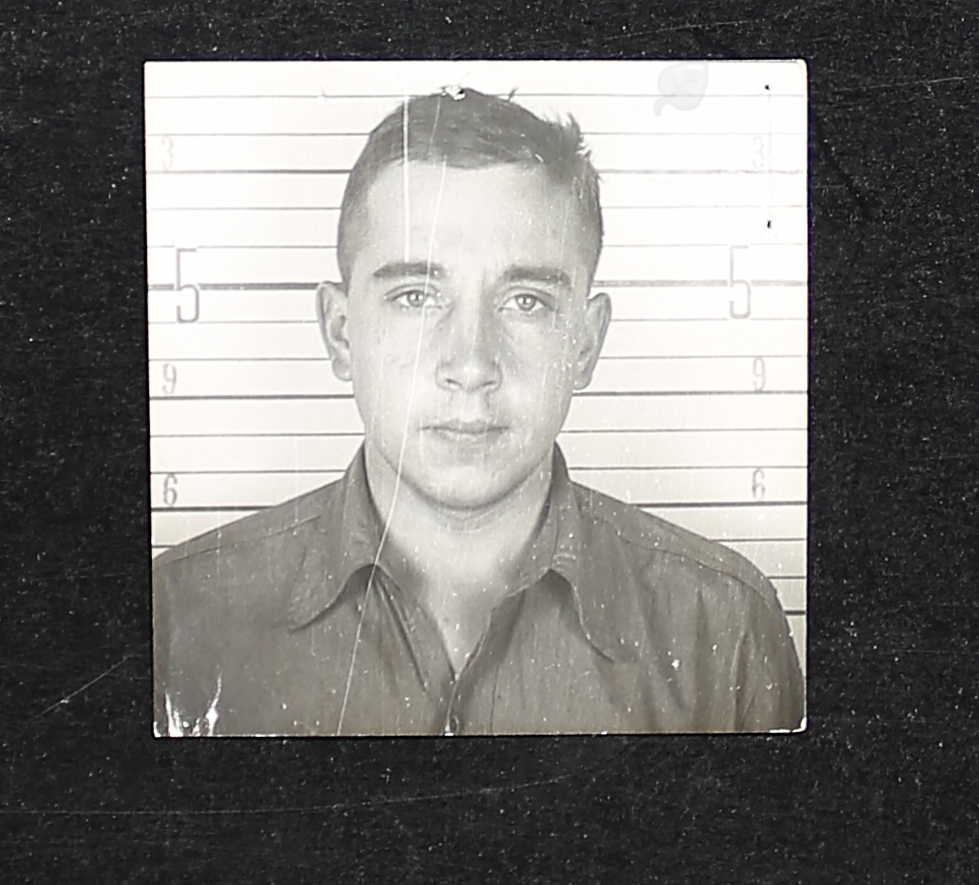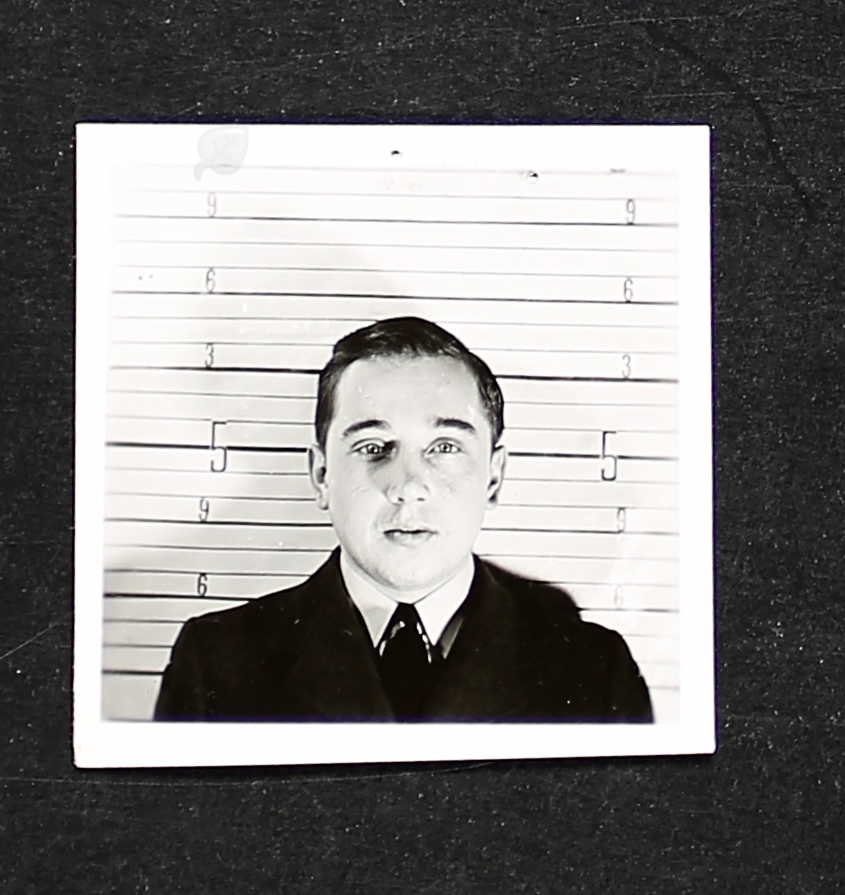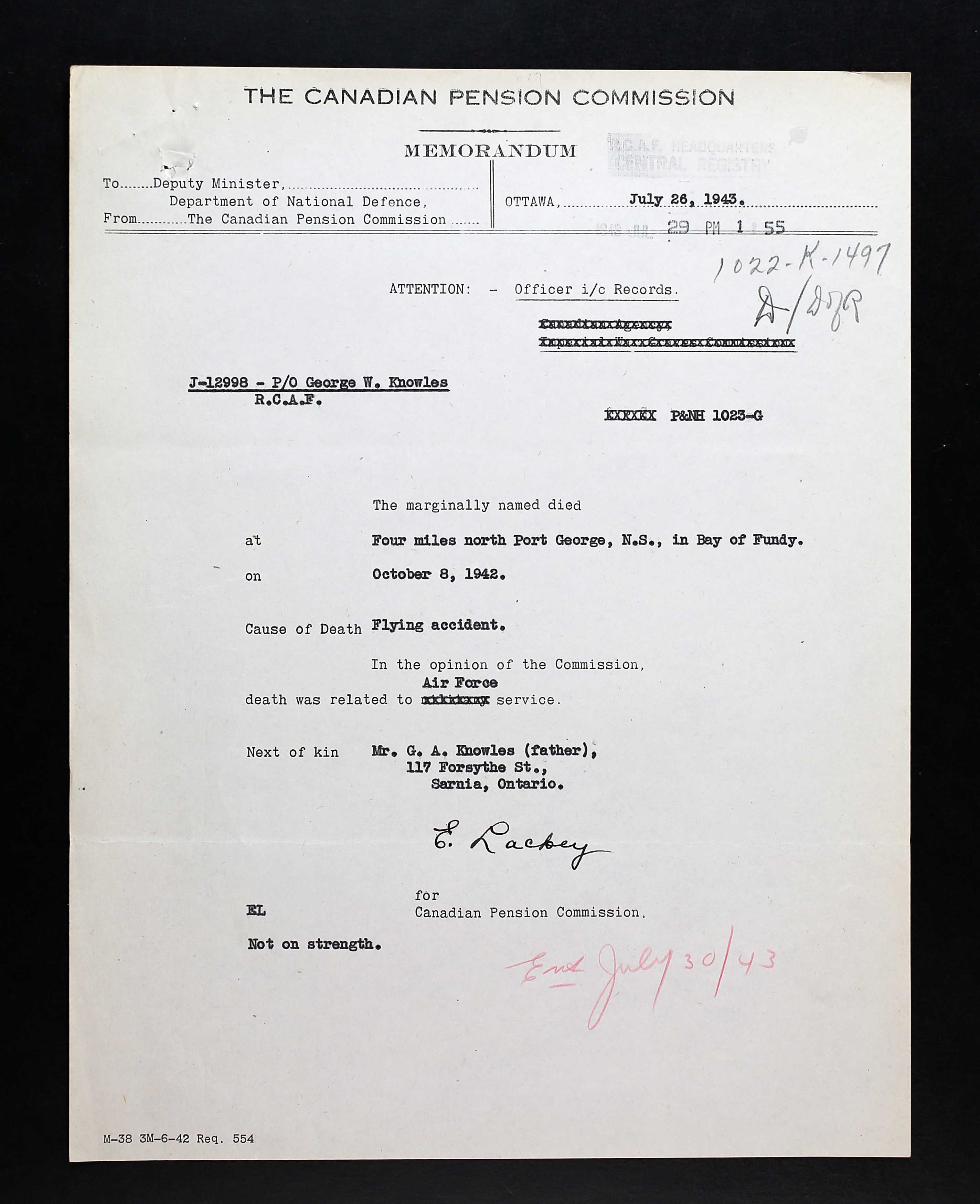


November 30, 1918 - October 8, 1942



George William Knowles was born in Kincardine, Fife, Scotland to George Allen Gordon Knowles (1894-1984), still runner at the Imperial Oil Ltd. and Catherine Young (nee Thompson) Knowles (1985-1985) of Sarnia, Ontario. He had one brother, Robert Edward Knowles (1935-1980) and one sister, Catherine Rebecca Knowles (b.1921). George lived in Scotland for eight months before the family immigrated to Canada. They lived in Bathurst, NB for 5 ½ years, then Iroquois Falls for six months, then settled down in Sarnia, Ontario. The family was Presbyterian.
George had his matriculation, except for math, and industrial school training. Prior military experience included the 2-26th Battery, RCA, Sarnia Signals, August 1940 to February 1941. “I am a signaller in the 2-26 Battery RCA and have a practical knowledge of Morse Code and the different procedure signals.”
He was a grocery clerk from September 1939 to April 1940 at The Great A&P and then a machinist at Meuller Bros Ltd. (plumbing and brass products) in Sarnia, prior to his enlistment with the RCAF in March 1941 at the London, Ontario Recruiting Centre. “I can run a lathe milling machine, shaper, drill press, and a few more minor machines along the machine shop line. I am interested in signalling. I am engaged in sports extensively. I have participated in all sports in various leagues in Western Ontario.” George was considered a good standard candidate. “Pleasant personality. Leaves the impression that he can take it as well as hand it out. Should make both an excellent Air Gunner and Wireless Operator.”
He stood 5’4” tall and weighed 139 ½ pounds. He had blue eyes and medium brown hair, with a medium complexion. A vertical 4” scar on his right cheek and a deformed end on his right thumb were noted. He smoked eight cigarettes per day and rarely drank alcohol.
George started his journey through the BCATP at No. 1 Manning Depot, Toronto, June 24 until August 3, 1941. He was then sent to No. 1 SFTS, Camp Borden from August 4 to November 8, 1941.
He was at No. 1 Wireless School, Montreal, Quebec, from November 9, 1941 until June 20, 1942. He was ill from November 28 to December 2, 1942. Here, he received his Wireless Operator’s Badge. George was 2nd in the class of 57 with a 90%.
He was then sent to No. 1 Bombing and Gunnery School at Jarvis, Ontario June 21 to August 14, 1942. George received his Air Gunner’s Badge in July 1942. He was 20th out of 32. Gunnery: “Cheerful and hardworking in his studies; has practical ability as well.” Final Assessment: “3rd in class of 32. Has been a most conscientious and good class leader – accepts responsibilities cheerfully and is most thorough in carrying out his duties. Suitable for commissioned rank.”
He was to be sent to Pennfield Ridge, NB, but that was cancelled. He returned to No. 1 BGS at Jarvis from August 3 to 7, 1942, then was sent to No. 36 O.T.U. Greenwood, NS August 8, 1942.
George had two life insurance policies with almost $300 in premiums paid towards them.
Hudson BW700 was taken on strength by Eastern Air Command March 25, 1942. First assigned to No. 36 O.T.U. RCAF Station Greenwood; crashed near Port George, NS, on the Bay of Fundy, 9 miles west of Greenwood at 12:00 on October 8, 1942. Was reported missing on air to sea firing exercise, all crew missing, presumed killed.
Aircrew: • Sergeant Douglas Wilson Armstrong, R117525 • Sergeant Robert Oliver Barrett, R99737 • Sergeant Benoit Desmarais, R124068 • Pilot Officer George William Knowles, J12998 • Flying Officer Jack Campbell McFarlane, J4748, Staff Pilot • Flight Sergeant Daniel Shackell, 745922 RAF, Staff Armament Officer, son of William and Ellen Shackell, husband of Violet, London, England • Pilot Officer Henry Raymond Woodman, J13145
COURT OF INQUIRY sat from October 12 to October 14, 1942.
“Purpose of the staff air gunner giving instruction to pupil air gunners in rear turret air firing at sea markers. The aircraft is still missing but is presumed to have crashed into the sea off Port George, Nova Scotia. Hudson BW700 took off from Greenwood to carry out air firing exercises on the ranges. Some fifteen minutes later an aircraft was seen to crash into the sea near the ranges, and it is presumed that it was Hudson BW700.”
FIRST WITNESS: Flying Officer Kenneth Lloyd Collinson, 87454 Duty Pilot: “On the 8th of October 1942, at approximately 1150 hours, whilst carrying out my duties as duty pilot in the control tower at No. 36 O.T.U. I received a telephone call from a woman stating she was a storekeeper at Port George and that a Miss Josephine Edwards had seen an aircraft dip low over the water, about a mile off land from Port George and then disappear. I inquired from the caller whether she could give any further details, but she was unable to do so. I therefore told her that I would send someone out to Port George and in the meantime if she received any further information to advise me immediately by telephone.
“Immediately after this telephone conversation with the storekeeper, I informed the Chief Inspector, Wing Commander Barron, of the details I had just received, and then I dispatched the ambulance to Port George with orders to report to the storekeeper. I then made inquiries at the flights and ascertain from B Flight that they had an aircraft carrying out air firing on the ranges at that moment. Arrangements were made and Squadron Leader Tacon took off at 1200 hours in a Hudson to search an area off Port George. A Lysander with Squadron Leader Holmes followed on a similar mission at 1205 hours.
“At 12:45 hours, a message was received from the medical officer, Flight Lieutenant Webster, who had accompanied the ambulance stating that he was in Port George and on making inquiries had ascertained from several witnesses that an aircraft was seen to hit the water about a mile offshore from Port George and then disappear from view. The medical officer was instructed to obtain the names and addresses of all witnesses and if possible, to obtain any further information.”
The second witness, Squadron Leader Ernest William Tacon, DFC, AF, RAF, 36196, (POW by September 1944, d. 2003) stated that he had observed several pieces of green debris, and oil patch to be 100 yards in length, and what appeared to be a partially submerged portion of a dinghy but no sign of human bodies. He circled the area for about 15 minutes without seeing any other sign of wreckage and returned to base./
The third witness, S/L Arthur Ray Holmes, RAF, 39524 stated that Hudson BW 700 was to carry out splash firing at aluminum sea markers in the Margaretville firing ranges. The aircraft took off from Greenwood at 11:30 hours. He also noticed an oil slick about 3 miles out to sea extending for about 300 feet parallel to the coastline. He carried out a low search for signs of evidence of a crashed aircraft and observed several small green objects floating in the water which resembled portions of the interior of a Hudson aircraft. He observed also what appeared to be a small portion of a dinghy sticking out of the water but no visible signs of human bodies or other wreckage so he returned to the aerodrome and reported what he had seen. At 1800 hours he accompanied a party in a boat to the estimated position where he had previously seen the oil slick but owing to the roughness of the sea and failing light, it was impossible for him to distinguish any sign of wreckage or the oil slick and the boat party returned at 1915 hours. During his flight of this aircraft on a similar firing exercise on the 8th of October 1942 at 0940 to 1105 hours, flown by Flying Officer McFarland, the aircraft behaved perfectly normally and was in all respects fully serviceable.
The fourth witness, P/O Peter Hillwood stated that the weather conditions over the area remained good for the whole day but towards the evening the sea became quite rough.
Miss Josephine Agnes Edwards of Port George stated that on the 8th of October 1942 about 11:30 hours, “I observed from my kitchen window a twin engine aircraft approaching from the direction of Greenwood, and when over Port George, the aircraft turned and flew easterly for a short distance. She then turned apparently and flew in a westerly direction, for the next time I noticed the aircraft, she was approaching the village from the west, parallel to the coastline and approximately about one mile offshore. When opposite my residence, I noticed the aircraft was doing a very steep bank close to the water. My impression at that moment was at the aircraft would not right itself and within a few seconds I saw her strike the water with one wing. There was a terrific splash and the aircraft disappeared from my view from the kitchen window. I then went outside and gave the alarm to Mr. Edward McKenzie who in turn went to the general store and asked Mrs. Margaret Rafuse to telephone Greenwood. The actual time of the crash was approximately 1140 hours and at about 1200 hours, I noticed an oil streak in the position where the aircraft was seen to disappear. So far as I know there were no other eyewitnesses who saw the actual crash.”
The seventh witness, W/C Oswald James Milman Barron, DFC, RAF, 33217 (died 1944, flying a Mosquito - name at Runneymede) stated that the quickest method of getting a boat out to the scene of the reported crash was to take a mobile crane and twenty men from the station in order to assist in launching a laid-up boat that was available at Margaretville, “however it was not until 1800 hours that evening that the boat was launched, and although I accompanied the boat to the scene of the reported crash, by that time there was no evidence of a crash anywhere to be found in the vicinity. I gave instructions to all crews of aircraft flying in that vicinity during the 9th and 10th of October 1942 to keep a sharp lookout for any sign of wreckage but nothing was seen. As soon as the reports from the crew detailed to search the area immediately following the report of a crash came to hand, and in view of the fact that Hudson BW700 was the duly aircraft from this unit detailed to fly in the Port George vicinity at that time, I was convinced that Hudson BW700 had crashed into the position reported.”
The eighth witness, S/L Allan Richmond Lloyd Griffiths, RAF, 37398, stated that they did not have a safety boat for No. 36 O.T.U. Air Firing Ranges. On the 25th of June 1942, he had written to the C/I and pointed out the “complete lack of a marine craft section for this Unit. However, during the summer months, it was possible to obtain local facilities in an emergency for air sea rescues, but as from about October 1, 1942, the local boats were pulled up for winter. Boats operate from Parker Cove, some 30 miles from the Air Firing ranges, during the winter, but there is no guarantee they would be available if required at short notice.”
CAUSE: Unknown. RECOMMENDATIONS: That a safety launch be provided to patrol the air firing and bombing ranges whilst air firing or bombing is in progress.
“Hudson BW700 was located in the sea approximately 1 ½ miles from shore off Port George, lying in 20 feet of water at low tide. Tidal current of 12 knots, boat was launched and proceeded to spot but found no wreckage. Have no other equipment which to salvage aircraft.”